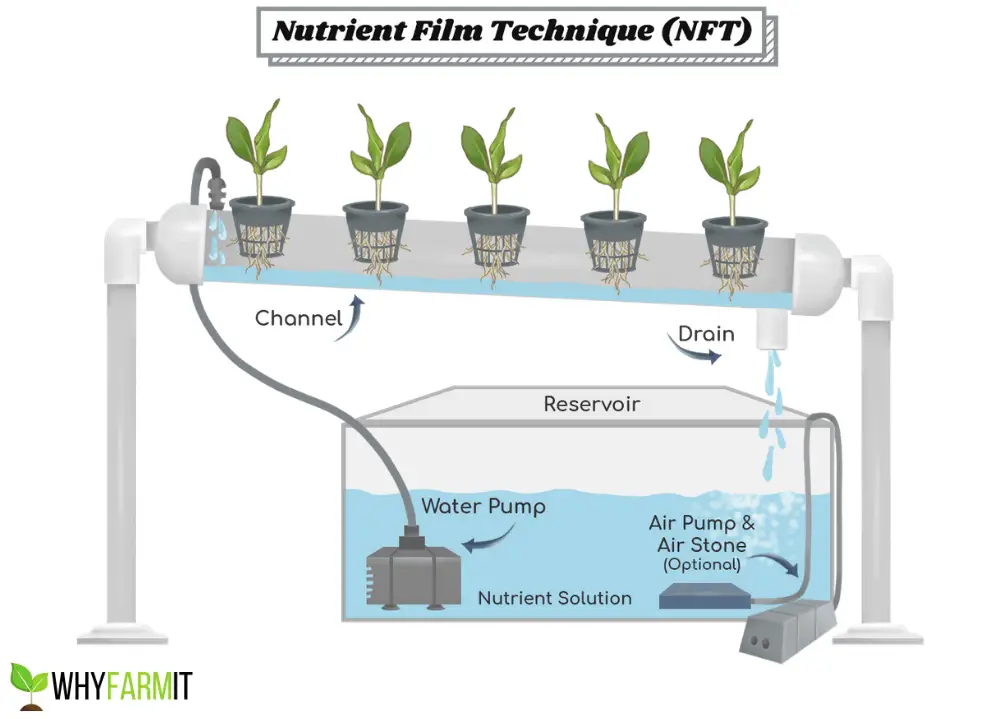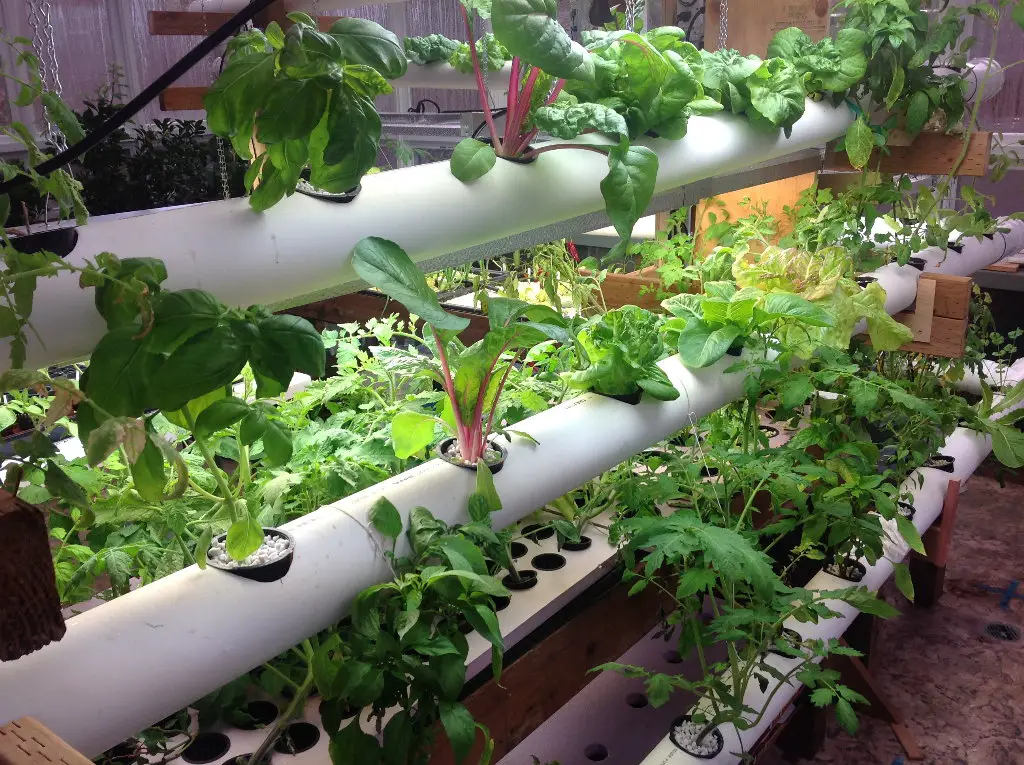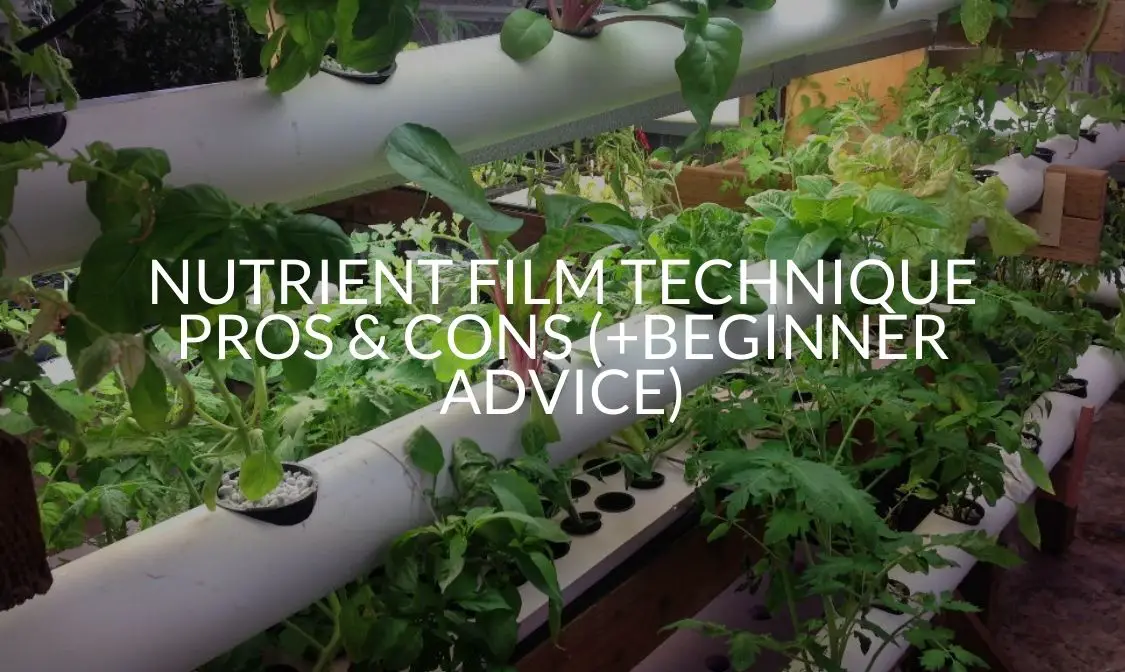You’ve been gardening for a while now, and your greenhouse is full of lively flowers and plump veggies. Now you’re thinking about trying your hand at a hydroponic system for your plants since it takes a lot of the pressure off of regular watering. But there are a handful of different hydroponic setups, and deciding on which to go with can be tough.
You’ve probably heard about the Nutrient Film Technique method, and maybe some about the advantages and disadvantages of using such a system for your hydroponic set-up. In this article, we’ll examine some Nutrient Film Technique Pros and Cons. We’ll also answer some other pressing questions many people have on the subject.
What Is Nutrient Film Technique Hydroponics?
Nutrient Film Technique, or NFT, hydroponics is a method of hydroponic growing that employs a sloped channel the plants are seated in that feeds “used” water back into the reservoir below the tray. Many gardeners DIY channels out of PVC piping to save money over a commercial set-up.
Water is fed into the upper part of the channel so it flows down, providing water and nutrients to plants as it flows down the channel. In the reservoir, the water is aerated and “fed” with nutrients so that the plants stay happy and healthy.
NFT Hydroponics is generally a more complex method than the easier-to-set-up Deep-Water Culture. However, it is also more modular and can be scaled up easily so long as you keep your water flow, nutrient levels, and aeration dialed in properly. Many beginners will shy away from NFT due to the increased complexity, despite its advantages.
How Does NFT Hydroponics Work?
Now that your interest is piqued, let’s take a look at what all goes into an NFT hydroponic setup. To build yours, you’ll need a few things first.
Here’s a list of the components your NFT system will need to have:
- A reservoir: holds the water/nutrient solution
- A nutrient pump: pumps nutrient water to the channel where your plants are grown
- Tubing: carries the water fed by the pump up to the channel
- A channel: a long, sloped space for your plants to grow in
- Net pots: these contain your plants in a growing medium
- A return system: guides the nutrient water back into the reservoir after it’s been pumped into the channel
The two main components of an NFT system are the channels or grow trays and the reservoir of nutrient water. The net pots hold seedlings in the channels, which will need to be spaced out according to your plants’ needs. This allows the root systems to spread out in the channel and absorb water and nutrients from the channel directly.
The nutrient pump feeds water up tubing into the channel, where it runs down into the reservoir for reuse. This helps prevent overwatering since there is a constant trickle of nutrient water through the root systems of your crops. This thin film of nutrient solution carries enough water and necessary minerals and chemicals to keep your plants in ideal condition without worrying about watering and feeding your plants separately.

What is Hydroponic Nutrient Solution?
Plants, like any living organism, need nutrients to grow and thrive. In hydroponic systems, a solution of nutrients and water serves as a replacement for fertilizer and naturally occurring nutrients in soil-based grow. This solution contains all the necessary nutrients to support the growth of your crops. It’s much easier to measure levels of various nutrients in a solution than in the soil.
Plant nutrients come in three main forms, primary macronutrients, secondary macronutrients, and micronutrients.
Primary macronutrients include:
- Nitrogen: The most important nutrient for plants, nitrogen is a crucial part of many plant systems. The vegetative growth of plants is dependent on nitrogen availability, as is the formation of chlorophyll and other biochemicals like amino acids, proteins, and co-enzymes.
- Phosphorus: A key building block of DNA, Phosphorus is also highly important for plants. It is a key contributor to the development of roots, flowers, seeds, and fruits.
- Potassium: Another important nutrient, potassium acts as a catalyst for many plant systems, such as photosynthesis, protein synthesis, enzyme activity, and starch formation
These three are the most important and are needed in the largest quantities in a hydroponic nutrient solution.
Secondary macronutrients include:
- Calcium: Proper levels of calcium play a critical role in the development and cell formation. Too much can stunt growth, while too much can cause leaves to brown and die.
- Sulfur: A key component of the amino acids that are made into proteins, Sulfur is also an important component of some enzymes and vitamins.
- Magnesium: As a component of chlorophyll, magnesium is an important mineral for plants to get enough of. It is often consumed in larger quantities by plants that grow more quickly.
These three are also crucial for plant development but to a lesser degree than the first three.
Micronutrients include:
- Zinc: Zinc is important for the production of chlorophyll and nitrogen metabolism.
- Boron: Boron is a key component of cell membrane production, as well as seed formation.
- Iron: Iron is an integral part of many enzymes that control functions like nitrogen fixation and energy provision.
- Manganese: Manganese acts as a catalyst for growth and oxygen production.
The four micronutrients above are also considered important for the proper growth of your plants, though in smaller quantities than the macronutrients.
What Is the Best Growing Medium to Use in an NFT System?
Growing crops in the soil can leave you open to invading weeds and soil-borne diseases. One of the biggest advantages of any hydroponic system is the elimination of these risk factors. With a hydroponic system, you can control the nutrient and oxygen levels that your plants receive throughout their lifespan. So, if your plants aren’t grown in soil, what’s the best growing medium to use for NFT hydroponics?
Growing media may function similar to soil, but the nutrient water is the real replacement from a plant needs perspective. Growing media in NFT systems are more for supporting the plant since nutrient water is constantly flowing through the medium. Because of the regular water and nutrient availability, an NFT hydroponics system is well-suited to mediums with low Water Holding Capacity, like clay pebbles and expanded clay aggregate.

What Are the Pros of NFT Hydroponics Method?
Now that we know a bit more about what NFT systems are and how they operate, let’s look at some of the advantages of using an NFT hydroponic setup. Overall, it is a flexible, low-cost, and low-maintenance system, making it a favorite of many gardeners.
Distinct advantages like the following also make NFT hydroponics an attractive choice for growers:
- Lower nutrient and water consumption: The constant slow trickle of nutrient water keeps your plants healthy without risking overwatering
- Uses less growing media than other methods: This makes it often less messy and more cost-effective than other methods
- Easier to care for the roots: It’s easier to disinfect compromised root systems, and makes observing the root health of your crops much easier
- Prevents build-up of salts in the root area: Keeps your root systems at the proper levels of various minerals, salts, and other nutrients with a constant flow of water
- Minimal water contamination issues: Recirculation of nutrient water makes it less likely that contamination will establish a foothold
- Modular in design: NFT systems can be scaled-up for larger grows
Taken together, these points make a strong case for deciding to use an NFT system for your new hydroponic set-up.
What Are the Cons of NFT Hydroponics Method?
But what about the drawbacks? Surely, there must be some. As with any system, there are bound to be limits, so carefully consider what you’re going to grow and the requirements of those plants.
Limits of the Nutrient Film Technique method include:
- Clogged channels: Root clusters can grow quite expansively, running the risk of blocking the flow of nutrient water through the channel and back into the reservoir.
- Potential for pump failure: Even as short as a few hours of a downed pump can spell disaster for your crops.
- Not well-suited to use for some plants: Those with large taproots or who need lots of support should be avoided in NFT systems.
- Not good for saline water: Saline water will gradually drop in salinity if used in an NFT system.
These limitations are pretty significant, so weigh them carefully against other methods of growing hydroponically.
What Plants Grow Best with NFT Hydroponics Methods?
So, you’ve decided on a Nutrient Film Technique system for your hydroponic set-up. Now comes the ultimate question: What to grow in your NFT system? It’s an important question to answer before building your setup. Some plants are perfect for NFT systems, while others are not such good ideas.
NFT systems are best suited to growing leafy greens with short growing cycles. Some other plants, like herbs and strawberries, can be grown with some success. Crops with large taproots, such as carrots and beets, are not well-suited to NFT systems. Larger, heavier leafy greens like cabbage may also prove problematic to grow.
Spacing your seedlings out properly is important, so if building your own be sure to drill holes for your net pots in the proper places for the crops you plan to grow. Bunching them up too closely can cause growth issues, as well as entangled roots that may block your channel.
Vegetables That Grow Well with NFT Methods
What vegetable grows well in an NFT system? As stated above, leafy greens with short lifespans dominate the NFT hydroponics world. If you’re looking to up your salad game with home-grown veggies, then an NFT system may be right for you.
Veggies that grow well in Nutrient Film Technique systems include:
- Bibb lettuce: A type of Butter lettuce, Bibb lettuce is a soft, buttery green that harvests in 6-8 weeks.
- Leaf lettuce: Leaf lettuces do not grow in “heads” and are often easier to grow than romaine or other head lettuces. Like Bibb lettuce, it is harvested in about 6-8 weeks.
- Spinach: Spinach, a cool-season crop with many nutritional benefits, is also easy to grow in an NFT hydroponic system. It can be harvested in 5-7 weeks.
- Broccoli Raab: Another cool-season crop best sown in early spring, broccoli raab makes a great addition to your NFT system. Varieties range in maturation time, with some harvestable at 40-45 days, while others take up to 75 days.
Herbs That Grow Well with NFT Methods
What if you’d rather not grow veggies? Perhaps you’d prefer an aromatic hydroponic garden filled with herbs. If that’s the case, you may be wondering which herbs tend to grow well in an NFT system?
Herbs that do well in NFT systems include:
- Basil: Continually harvestable at maturity, basil is a popular herb in many cuisines that is easy to grow in NFT systems. Basil needs upwards of 11 hours of light per day, so be sure you can facilitate this much full sunlight or have an artificial light source.
- Mints: Mints, like spearmint and peppermint, have roots that grow quickly, making them ideal for hydroponic grows.
- Chives: Chives can be grown with relative ease in hydroponic systems, and reach maturity at 6-8 weeks. At that time, they become continually harvestable at 3–4-week intervals while the plant regrows.
Fruits That Grow Well with NFT Methods
Maybe you’ve got a hankering for home-grown fruit? Can you grow anything sweet and juicy with an NFT hydroponic system? You sure can!
NFT systems are best known for growing fruit like:
- Strawberries: Strawberries have a short growth cycle and are pretty well suited to hydroponics, specifically NFT set-ups. They have been grown commercially in NFT systems for decades.
- Blueberries: Blueberries are high in vitamins, and though they take longer to grow than strawberries (up to the second year in some cases) they still do well in NFT systems.
Who is NFT Hydroponics Best for?
Nutrient Film Technique hydroponics are best suited to a few types of people. Those who have a do-it-yourself streak like the simplicity and cheapness of their construction. People who prefer a lower-maintenance system will likely prefer the NFT. Growers who want leafy greens, herbs like basil, or fresh berries would also do well to try out an NFT system.
Recap
In summation, the Nutrient Film Technique is a method of hydroponic growing. It employs a pump in the reservoir to bring water up to the channel (or grow tray), which is slanted to allow the nutrient water to drain back into the reservoir. This cuts down on water and nutrient consumption protects against overwatering and gives easy access to roots for care and maintenance.
An NFT system is a great way to grow leafy veggies, some herbs, and fruit like strawberries and blueberries. They are well-suited to gardeners who are particularly handy, or who want to take advantage of the relatively low maintenance requirements of NFT systems.


Great insights on the Nutrient Film Technique! I appreciate the detailed breakdown of the pros and cons. It really helps beginners like me understand what to expect. I’m particularly intrigued by the idea of increased efficiency in water usage. Any tips on how to manage nutrient balance effectively? Thanks for sharing!
If you have a testing kit, you can take multiple samples each day and record the results. Keep track of how often you replenish the nutrients and the ratio of A to B. Track room temperature as well if possible. Over time you can see how the nutrient water changes, how the plants respond to any changes, and if the tempurature has an impact on the nutrient water. You basically become a bit of a mad scientist for a while until you get the feel for what the plants react to best. After you have a base of experience with all the record keeping, and trial by error, you will not need to test as often.